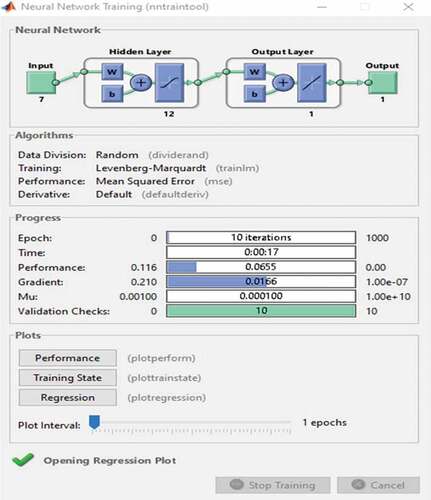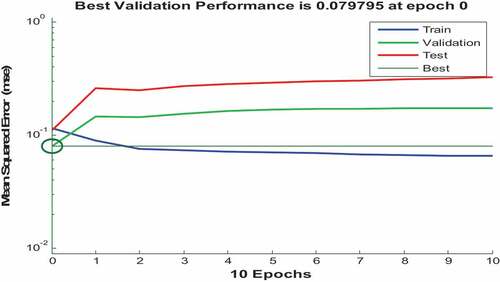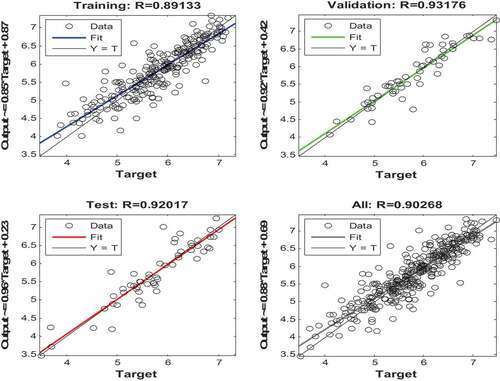 ?Mathematical formulae have been encoded as MathML and are displayed in this HTML version using MathJax in order to improve their display. Uncheck the box to turn MathJax off. This feature requires Javascript. Click on a formula to zoom.
?Mathematical formulae have been encoded as MathML and are displayed in this HTML version using MathJax in order to improve their display. Uncheck the box to turn MathJax off. This feature requires Javascript. Click on a formula to zoom.Abstract
Due to a lack of solar radiation measurement instruments in various regions across the world, particularly in Ethiopia, many empirical models have been developed to estimate global solar radiation. Reliable global solar radiation information is essential for the design and development of solar energy systems.Thus, the aim of this paper is to investigate the feasibility of using Artificial Neural Network (ANN) to predict mean daily global solar radiation (GSR) and to compare the performance of ANN and empirical models based on sunshine in estimating mean daily global solar irradiation on a horizontal surface.For the ANN model, network inputs were daily data for a number of days, average daily data (sunshine hours, maximum temperature, minimum temperature, wind speed, relative humidity, and pressure), and while daily averaged global solar radiation was the network output.After training, the model had R values of 0.891 for training, 0.932 for validation, 0.920 for testing, and 0.903 for all, with validation performance of 0.0797.The results of the ANN model were compared to the empirical equations using statistical error evaluation (MBEANN = 0.0005, RMSEANN = 0.3310, and R2ANN = 0.7998).The agreement between the values of NASA and estimated values reveals that the ANN exhibits good performance in studying daily GSR. The result also shows that the mean daily GSR is varying between 3.675KWh/m2 (August-1) and 6.935 KWh/m2 (April-19) in the study site.
PUBLIC INTEREST STATEMENT
The use of artificial neural networks and empirical sunlight equations in the prediction of daily global solar radiation is reported in this paper.
It confirms the artificial neural network’s ability to forecast daily global solar radiation.
The outcomes of this research will aid in the precise exploitation of solar energy resources throughout Ethiopia.
1. Introduction
The sun is an abundant, free, infinite, green, reliable, renewable, and sustainable energy resource. It also has a large potential to fulfill the energy demands of the world and it is projected that it will be widely utilized in the immediate future (Ağbulut et al., Citation2021; Khanlari et al., Citation2020; Khanlari et al., Citation2020; Salcedo-Sanz et al., Citation2014).To determine a region's solar energy potential, it is necessary to have GSR data for that location (Ağbulut etal., Citation2021; Malik etal., Citation2019; Yıldırım etal., Citation2018).In the last few decades, global incident solar radiation has been widely investigated worldwide, driven by the rising price of oil, global warming issues, and the growing electrical energy demand due to industrialization and expansion of thriving economies (Hai et al., Citation2020; Yadav & Chandel, Citation2013). Global incident solar radiation is received in the form of usable energy that originally exists in sunlight. This type of energy can be converted into (i) electricity using photovoltaic, (ii) thermal energy where it can be utilized for water heating, and (iii) chemical energy from photoelectron chemical tools for generating solar fuels (Zobaa & Bansal, Citation2011). All of these forms of energy require adequately mapped resources in regions where they are in abundance.Ethiopia has a higher potential to exploit renewable energies for domestic applications. This vast renewable energy resource potential was not exploited sufficiently in the country, primarily due to the lack of scientific and methodological know-how concerning planning, site selection, and technical implementation. A further constraint prohibiting their utilization was that the real potential of this resource’s location is not well-known, because of the lack of research emphasis (Gebrehiwot et al., Citation2019; Nebey et al., Citation2020; Woldegiyorgis, Citation2019a).
Many models have been proposed to predict solar radiation using measured meteorological parameters such as sunshine hours, temperature, humidity, cloud cover, and so on. Fan et al. (Fan et al., Citation2018) and Quej et al. (Quej et al., Citation2017) have designed empirical models to assess the global solar irradiation over a horizontal surface. In the literature, a few researchers have done in Ethiopia to predict global solar irradiance using empirical models (Benti & Tadesse, Citation2017; Nage, Citation2018; Woldegiyorgis, Citation2020, Citation2019b).
Different geographical and meteorological variables of a specific location can be used as ANN inputs for the prediction of solar radiation (Prakash et al., Citation2018). Mohandes et al. (Mohandes et al., Citation1998) predicted the global solar radiation as a function of latitude, longitude, altitude, and sunshine duration in Saudi Arabia. Rehman and Mohandes (Rehman & Mohandes, Citation2009) studied four combinations of input parameters, day, maximum air temperature, mean air temperature, and relative humidity estimate diffuse solar radiation for the Abha city in Saudi Arabia. It was found that using relative humidity and daily mean temperature gives better results than other combinations. Azeez (Rehman & Mohandes, Citation2008) used Feed forward back propagation Neural Network for monthly estimation of average global solar radiation in Gusau, Nigeria. The sunshine duration, maximum ambient temperature, and relative humidity are taken as input and solar radiation as output. The statistical analysis has shown good agreement between the estimated and measured values of global solar radiation.
So far, there are a few studies on the prediction of GSR in Ethiopia’s using ANN model. The solar duration fraction of the empirical model of Angstrom-Prescott linear correlation and the ANNs model of generalized regression neural network were considered in Mekelle, Ethiopia (Gebreyohannes et al., Citation2020). Younas et al. (Younas et al., Citation2016) concluded that Back–Propagation Artificial Neural Network can be used to predict GSR of Addis Ababa, Ethiopia, at a minimum cost and reasonable accuracy. Therefore, the objective of the current work was to analyze and evaluate the effectiveness, feasibility of the sunshine empirical and ANN models in the prediction of daily global solar radiation. This study utilizes the sunshine hours, maximum temperature, minimum temperature, relative humidity, wind speed, and pressure data as input for ANNs to predict the daily GSR on horizontal surfaces for Lalibela in Ethiopia.
2. Materials and methods
2.1. Data collection
In this study, the meteorological data consist of daily (maximum temperature, minimum temperature, relative humidity, wind speed, pressure, and global solar radiation) were taken from the National Aeronautical Space Administration (NASA) online database (NASA, World Surface Metrology, Citation2021) and sunshine hours from Kombolcha meteorological agency in the period of 2014–2016. The choice of parameters varies according to the author’s approaches and the regions studied. Indeed, a relevant parameter to a case study may not play an important role in different circumstances. The choice of a parameter may also be constrained by the availability of measured data (Rocha et al., Citation2019). Previous studies show that the ANN technology has a powerful ability when dealing with prediction issues. ANN modeling requires input parameters. Through some hidden calculations happened between the input and hidden layer, then between the hidden and output layers, it generates output values. This process is called Feed-Forward Neural Network (FFNN) (Gaballa & Cho, Citation2019; Yadav & Chandel, Citation2014). The proposed ANN and sunshine empirical models are implemented in the MATLAB software package. The period of the data set is 3 years, from 01–01-2014 to 31–12-2016 with a total of 365 data.
2.2. Data analysis
The data collected were daily data, but were processed to mean with the Microsoft Excel package. The input from the processed, filed out of the seven columns as the input data, with the help of MATLAB. The NASA result data were also inputted, but as “targeted data”. This study is carried out based on the following steps:
Step 1: The collected sample data is divided into two sets, one for constructing the model, called the training dataset, which was generated from 70% (256-of total data), and the other one for evaluating the estimated model, called the testing dataset, which was built from the 30% (109- data).
Step 2: Determination of input variables for the model is performed.
Step 3: Construction of the model: The architecture of ANN is constructed and developed.
Step 4: The predicting ability for the proposed model is evaluated. Moreover, the predicted outputs are compared with the NASA result, and error is calculated. A statistical indicator, RMSE is employed to validate the models.
A MATLAB R2013a, Neural Network/Data Manager Tool: (nntool) was used for building, training, and testing models. In this study, the output layer consists of one neuron, and the seven neurons in the input layer correlate with the number of input variables in the network. The number of neurons in the hidden layer is determined through the process of running a model with a small number of neurons and increasing until the predictive results and predictive error reach the allowed value (i.e 12). The hyperbolic tangent sigmoid math function is used to transform information in the layers of the network, and the ANN network is set up and run in the MATLAB environment. Its configuration details are listed in .
Table 1. Configuration
2.3. Sunshine based model
2.3.1. Angstrom- Prescott model (AP)
Sunshine-based models are the most commonly used model for predicting global solar radiation globally as a result of the availability and reliable measured relative sunshine duration data in most meteorological stations in Africa and across the globe (Angstrom, Citation1924; Prescott, Citation1940). The Angstrom-Prescot empirical model uses sunshine duration to estimate solar radiation using a first-order linear correlation which is shown in EquationEquation (1)(1)
(1) ; it defines the relationship between solar energy available at the ground level and the sunshine duration (Amou et al., Citation2017; Contreras-Sepúlveda et al., Citation2021; Paulescu et al., Citation2016).
Where: Rs: Daily solar irradiation on a horizontal surface; Ra: Daily extraterrestrial irradiation on a horizontal surface; n: number of hours measured by the sunshine recorder; N: maximum daily sunshine duration (a, b): empirically determined regression constants.
Ra is also provided as (Allen et al., Citation1998; Chineke, Citation2008; Suwarn, Citation2017);
Where dr is the relative distance between the Earth and the Sun (EquationEquation (3)(3)
(3) ); t is the sunset hour angle in radians (EquationEquation (4)
(4)
(4) ),
is the latitude, and
is the solar declination angle in radians (EquationEquation (5)
(5)
(5) ):
In EquationEquations (3)(3)
(3) and (Equation5
(5)
(5) ), J is the Julian day number (i.e. J = 1 for 1 January). Finally, N, the maximum possible sunshine duration can be calculated using:
2.3.2. Louche model (LO)
Louche et al. (Zhang et al., Citation2018), (Almorox & Hontoria, Citation2004) have modified the AP model through the use of the ratio of (n/Nnh) instead of (n/N) and the equation is presented as follows:
Where a and b are the empirical coefficients.
2.3.3. Glover McCulloch model (GM)
Glover and McCulloch (Allen et al., Citation1998), (Almorox & Hontoria, Citation2004) suggested the following model, which took into account the effect of latitude of the site φ as an additional input and was valid for :
Where a and b are the empirical coefficients.
2.4. Artificial Neural Network
ANN is an ideal solution tool for modeling systems with non-linear relationships and it is a widely used method both for regression and classification problems. So there is no need for complex mathematical expressions to describe such systems (Ağbulut et al., Citation2021; Mabel & Fernandez, Citation2008; Methaprayoon et al., Citation2007). ANN is a network structure consisting of elements with process capability called neurons (). However, the created neural network structure must be trained to establish the relationship between inputs and outputs (Methaprayoon et al., Citation2007; Palani et al., Citation2008). In this respect, it is very similar to the information processing mechanism of the human brain (Behrang et al., Citation2010).
3. Evaluation of prediction performance
The performances of the models were evaluated based on the following statistical error indicators: Root mean square error (RMSE), Mean biased error (MBE), and coefficient of correlation (R) recommended by (Akinoǧlu & Ecevit, Citation1990; Wainaina et al., Citation2017). According to (Wainaina et al., Citation2017; Wainaina et al., Citation2017; Stone, Citation1993), the Root mean square error (RMSE) measures the short-term prediction quality of the correlation and defined as;
The Mean biased error (MBE) provides information on the long-term performance models. A low MBE is ideal. A positive value gives the average of overestimation in the predicted values and vice versa (Stone, Citation1993; Wainaina et al., Citation2017). MBE is defined as;
The closeness of these two indicators to zero leads to high modeling accuracy.
The coefficient of determination (R2) reflects the quality of the model. The model tends to perform better when R2 is closed to 1.
Rsi,m, Rsi,p is the measured and estimated global solar irradiation value, the average value of the measured global solar irradiation, and n is the number of observations (Benkaciali et al., Citation2016; Gueymard, Citation2014).
4. Results and Discussion
For the evaluation of daily mean global solar radiation, ANN, as well as three sunshine empirical models, has been proposed for Lalibela, Ethiopia. present the performance results from the ANN and sunshine empirical models. The ANN and sunshine empirical models are compared with values of NASA based on statistical parameters viz. MBE, RMSE, and R2. It can be verified that the value of the coefficient of determination (R2) is 0.7998 for the ANN model and sunshine models vary between 0.126 and 0.1706. The mean biased error (MBE) is −0.0005 for ANN and sunshine models varies between −0.468 and −0.055 for daily averaged GSR. The negative values of mean bias error (MBE) indicate the underestimation of daily mean GSR. The RMSE for the proposed models of sunshine varies from 1.071 (KWh/m2) to 1.263 (KWh/m2), while for ANN proposed model 0.3310 (KWh/m2). Thus, it is deduced that the estimated values of daily mean GSR from ANN models and values of NASA accompany each other. From all the statistical parameters calculated, it is noted that the proposed ANN model gives better performance characteristics than the sunshine empirical models for both monthly and daily averaged GSR.
Table 2. Performance evaluations by statistical errors for proposed models (Mean daily GSR)
Table 3. Performance evaluations by statistical errors for proposed models (Monthly averaged daily GSR)
is the performance plot after the training, testing, and validation. It is a plot of number epochs and Mean Squared Error. The best validation performance occurred at zero epochs with a performance value of 0.079. Also, training, validation, testing, and the best performance curve are shown by red, green, dotted lines, and blue respectively.
is the plot between Target and Output. This graph is plotted for training, testing, validation, and all. The R-value of Training is 0.8913, for validation is 0.9317, for Testing is 0.9202 and for all, it is 0.9027. These values are closer to 1. Four plots had shown the output of the training, validation, and testing data. These plots show how the model will be able to predict results after erudition from the relationships between the input and target variables. These values indicate that the fit is good. The regression (R-value) is 90.27% for the total response.
Figure 4. Mean daily global solar radiation from (2014–20,160) using ANN and sunshine empirical models
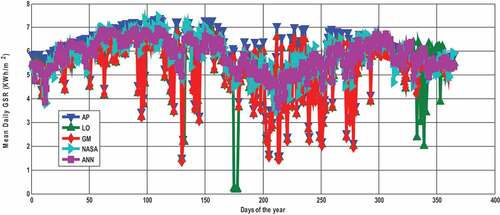
From illustrations, it is obvious that NASA value and the result of the ANN model showed a better fit than the sunshine empirical models. The statistical performance evaluation (MBE−ANN = −0.0004 KWh/m2, RSME−ANN = 0.3478 KWh/m2, and R2−ANN = 0.7279) is shown in . The minimum mean daily global solar radiation was founded in August- 1 (3.675 KWh/m2), January-12 (3.876 KWh/m2), July-31 (4.002 KWh/m2), August-2 (4.009 KWh/m2), August-6 (4.039 KWh/m2) and August-7 (4.226 KWh/m2) respectively. The maximum mean daily global solar radiation was occurring on a day of April-19 (6.935 KWh/m2), 31-March (6.9136 KWh/m2), 20-April (6.895 KWh/m2), March-2 (6.880 KWh/m2), March-29 (6.870 KWh/m2), March-11 (6.858 KWh/m2), April-23 (6.8468 KWh/m2) and March-3 (6.8468 KWh/m2) in order in the study period of (2014–2016). Generally, the minimum mean daily global solar radiation is found in August while the maximum mean daily global solar radiation occurred in March as shown in .
Figure 5. Monthly averaged daily global solar radiation from (2014–2016) using ANN and Sunshine empirical models
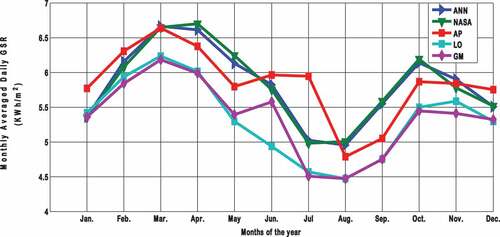
According to statistical indicator values (MBE−ANN = −0.0056 KWh/m2, RSME−ANN = 0.0433 KWh/m2 and R2−ANN = 0.9842), the ANN model is the best in the estimation of monthly averaged daily GSR as presented in . The minimum monthly averaged daily GSR was founded in August (4.954 KWh/m2), July (5.026 KWh/m2), and January (5.358 KWh/m2) respectively. The maximum monthly averaged daily GSR was occurred in March (6.663 KWh/m2), April (6.610 KWh/m2), and February (6.157 KWh/m2) in order in the study period of 2014–2016. As illustrated in , the best fit is found between the values of NASA and the results of the ANN model for both daily and monthly averaged GSR. Generally, the analysis of the statistical error for this study provides to conclude that the monthly averaged prediction of GSR was more accurate than daily ().
5. Conclusion
The implantation of Artificial Neural Network and sunshine empirical equations in the predicting of daily GSR is reported. The ANN model is developed by using meteorological parameters like days of a year, sunshine hours, maximum temperature, minimum temperature, wind speed, pressure, and relative humidity data as input. The results of validation with sunshine empirical models indicate that the ANN-based estimation is more suitable to predict the daily GSR in the study site. This study confirms the ability of the ANN model to predict daily GSR values precisely. It is also evident that ANN can be used as a highly effective tool for the prediction of daily GSR. The result obtained shows that a good solar potential and consequently suitable for the exploitation of solar energy systems in the study site. The ANN model will be suitable for predicting GSR for other locations in Ethiopia.
Acknowledgements
The authors wish to express their earnest gratitude to Kombolcha Meteorological Agency, Ethiopia, for providing the necessary facilities required to carry out this paper.
Disclosure statement
No potential conflict of interest was reported by the author(s).
Data availability
The data used to support the finding of this study was released upon NASA, World Surface Metrology (n.d.). That can be contacted at http://power.larc.nasa.gov/cgi bin/SSE/retscreen.cgi? [email protected] was obtained from NASA.
Additional information
Funding
Notes on contributors
Ashenafi Admasu
Tegenu Argaw Woldegiyorgis is a lecturer in the physics department at Wollo University’s College of Natural Science, where he focuses on renewable energy sources.
Renewable energy sources such as solar, wind, biomass, and biogas are of particular interest to him.
References
- Ağbulut, Ü., Gürel, A. E., & Biçen, Y. (2021). Prediction of daily global solar radiation using differDepartment of Physics, College of Natural Science, Wollo University, Dessie, Ethiopiaent machine learning algorithms: Evaluation and comparison. Renewable and Sustainable Energy Reviews, 135(2021), 110114. https://doi.org/10.1016/j.rser.2020.110114
- Akinoǧlu, B. G., & Ecevit, A. (1990). Construction of a quadratic model using modified Ångstrom coefficients to estimate global solar radiation. Solar Energy, 45(2), 85–12. https://doi.org/10.1016/0038-092X(90)90032-8
- Allen, R. G., Pereira, L. S., Raes, D., & Smith, M. (1998). Crop evapotranspiration-guidelines for computing crop water requirements-FAO Irrigation and drainage paper 56. Fao, Rome, 300(9).
- Almorox, J. Y., & Hontoria, C. (2004). Global solar radiation estimation using sunshine duration in Spain. Energy Conversion and Management, 45(9–10), 1529–1535. https://doi.org/10.1016/j.enconman.2003.08.022
- Amou, K. A., Sagna, K., Lare, Y., & Napo, K. (2017). Modeling of the solar potential of Lomé, Atakpamé and mango from weather data in Togo. Science, 5(3), 58–62. https://doi.org/10.11648/j.sjee.20170503.11
- Angstrom, A. (1924). Solar and terrestrial radiation. Report to the international commission for solar research on actinometric investigations of solar and atmospheric radiation. Quarterly Journal of the Royal Meteorological Society, 50(210), 121–126. https://doi.org/10.1002/qj.49705021008
- Behrang, M. A., Assareh, E., Ghanbarzadeh, A., & Noghrehabadi, A. R. (2010). The potential of different artificial neural network (ANN) techniques in daily global solar radiation modeling based on meteorological data. Solar Energy, 84(8), 1468–1480. https://doi.org/10.1016/j.solener.2010.05.009
- Benkaciali, S., Haddadi, M., Khellaf, A., Gairaa, K., & Guermoui, M. (2016). Evaluation of the global solar irradiation from the artificial neural network technique. Revue des Energies Renouvelables, 19(4), 617–631.
- Benti, N. E., & Tadesse, G. (2017). Feasibility study of solar photovoltaic (pv) energy systems for rural villages of Ethiopian Somali region (a case study of jigjiga zone). American Journal of Science, Engineering and Technology, 1(2), 42–48. https://doi.org/10.11648/j.ajset.20160102.14
- Chineke, T. C. (2008). Equations for estimating global solar radiation in data sparse regions. Renewable Energy, 33(4), 827–831. https://doi.org/10.1016/j.renene.2007.01.018
- Contreras-Sepúlveda, W., Galban-Pineda, M. G., Bustos-Márquez, L. F., Sepúlveda-Mora, S. B., & Ramírez-Mateus, J. J. (2021). Angström-Prescott empirical model to estimate solar radiation in Norte de Santander, Colombia. REVISTA DE INVESTIGACIÓN, DESARROLLO E INNOVACIÓN, 11(2), 413–428. https://doi.org/10.19053/20278306.v11.n2.2021.12765
- Fan, J., Wang, X., Wu, L., Zhang, F., Bai, H., Lu, X., & Xiang, Y. (2018). New combined models for estimating daily global solar radiation based on sunshine duration in humid regions: A case study in South China. Energy Conversion and Management, 156(2018), 618–625. https://doi.org/10.1016/j.enconman.2017.11.085
- Gaballa, H., & Cho, S. (2019). Prediction of hourly solar radiation using temperature and humidity for real-time building energy simulation. Journal of Physics. Conference Series, 1343(1), 012049. IOP Publishing
- Gebrehiwot, K., Mondal, M. A. H., Ringler, C., & Gebremeskel, A. G. (2019). Optimization and cost-benefit assessment of hybrid power systems for off-grid rural electrification in Ethiopia. Energy, 177(2019), 234–246. https://doi.org/10.1016/j.energy.2019.04.095
- Gebreyohannes, Y., Bayray, M., Lauwaert, J., & Mekelle, E. (2020) Estimation of daily solar radiation using SDF and ANN regression models. 1st International Conference on Engineering and Technology/ICET2020/ (pp. 86–97).
- https://doi.org/10.11648/j.jeece.20190403.12
- Gueymard, C. A. (2014). A review of validation methodologies and statistical performance indicators for modeled solar radiation data: Towards a better bankability of solar projects. Renewable and Sustainable Energy Reviews, 39(2014), 1024–1034. https://doi.org/10.1016/j.rser.2014.07.117
- Hai, T., Sharafati, A., Mohammed, A., Salih, S. Q., Deo, R. C., Al-Ansari, N., & Yaseen, Z. M. (2020). Global solar radiation estimation and climatic variability analysis using extreme learning machine-based predictive model. IEEE Access, 8(2020), 12026–12042. https://doi.org/10.1109/ACCESS.2020.2965303
- Khanlari, A., Sözen, A., Afshari, F., Şirin, C., Tuncer, A. D., & Gungor, A. (2020). Drying municipal sewage sludge with v-groove triple-pass and quadruple-pass solar air heaters along with testing of a solar absorber drying chamber. Science of the Total Environment, 709(2020), 136198. https://doi.org/10.1016/j.scitotenv.2019.136198
- Khanlari, A., Sözen, A., Şirin, C., Tuncer, A. D., & Gungor, A. (2020). Performance enhancement of a greenhouse dryer: Analysis of a cost-effective alternative solar air heater. Journal of Cleaner Production, 251(2020), 119672. https://doi.org/10.1016/j.jclepro.2019.119672
- Mabel, M. C., & Fernandez, E. (2008). Analysis of wind power generation and prediction using ANN: A case study. Renewable Energy, 33(5), 986–992. https://doi.org/10.1016/j.renene.2007.06.013
- Malik, H., Padmanabhan, V., & Sharma, R. (2019). PSO-NN-based hybrid model for long-term wind speed prediction: A study on 67 cities of India. In Applications of Artificial Intelligence Techniques in Engineering (pp. 319–327). Springer.
- Methaprayoon, K., Yingvivatanapong, C., Lee, W. J., & Liao, J. R. (2007). An integration of ANN wind power estimation into unit commitment considering the forecasting uncertainty. IEEE Transactions on Industry Applications, 43(6), 1441–1448. https://doi.org/10.1109/TIA.2007.908203
- Mohandes, M., Rehman, S., & Halawani, T. O. (1998). Estimation of global solar radiation using artificial neural networks. Renewable Energy, 14(1–4), 179–184. https://doi.org/10.1016/S0960-1481(98)00065-2
- Nage, G. D. (2018). Estimation of monthly average daily solar radiation from meteorological parameters: Sunshine hours and measured temperature in Tepi, Ethiopia. International Journal of Energy and Environmental Science, 3(1), 19–26. https://doi.org/10.11648/j.ijees.20180301.12
- NASA, World Surface Metrology. (2021). Retrieved May 16, 2021. http://power.larc.nasa.gov/cgibin/sse/[email protected]
- Nebey, A. H., Taye, B. Z., & Workineh, T. G. (2020). Site suitability analysis of solar PV power generation in South Gondar. Amhara Region. Journal of Energy, (2020). https://doi.org/10.1155/2020/3519257
- Palani, S., Liong, S. Y., & Tkalich, P. (2008). An ANN application for water quality forecasting. Marine Pollution Bulletin, 56(9), 1586–1597. https://doi.org/10.1016/j.marpolbul.2008.05.021
- Paulescu, M., Stefu, N., Calinoiu, D., Paulescu, E., Pop, N., Boata, R., & Mares, O. (2016). Ångström–Prescott equation: Physical basis, empirical models and sensitivity analysis. Renewable and Sustainable Energy Reviews, 62(2016), 495–506. https://doi.org/10.1016/j.rser.2016.04.012
- Prakash, S., Gopinath, N. P., & Suganthi, J. (2018). Wind and solar energy forecasting system using artificial neural networks. International Journal of Pure and Applied Mathematics, 118(5), 845–854.
- Prescott, J. A. (1940). Evaporation from water surface in relation to solar radiation. Transactions of the Royal Society of South Australia, 46(1940), 114–118.
- Quej, V. H., Almorox, J., Ibrakhimov, M., & Saito, L. (2017). Estimating daily global solar radiation by day of the year in six cities located in the Yucatán Peninsula, Mexico. Journal of Cleaner Production, 141(2017), 75–82. https://doi.org/10.1016/j.jclepro.2016.09.062
- Rehman, S., & Mohandes, M. (2008). Artificial neural network estimation of global solar radiation using air temperature and relative humidity. Energy Policy, 36(2), 571–576. https://doi.org/10.1016/j.enpol.2007.09.033
- Rehman, S., & Mohandes, M. (2009). Estimation of diffuse fraction of global solar radiation using artificial neural networks. Energy Sources, Part A, 31(11), 974–984. https://doi.org/10.1080/15567030801904582
- Rocha, P. C., Fernandes, J. L., Modolo, A. B., Lima, R. P., Da Silva, M. V., & Bezerra, C. D. (2019). Estimation of daily, weekly and monthly global solar radiation using ANNs and a long data set: A case study of Fortaleza, in Brazilian Northeast region. International Journal of Energy and Environmental Engineering, 10(3), 319–334. https://doi.org/10.1007/s40095-019-0313-0
- Salcedo-Sanz, S., Casanova-Mateo, C., Pastor-Sánchez, A., & Sánchez-Girón, M. (2014). Daily global solar radiation prediction based on a hybrid coral reefs optimization–extreme learning machine approach. Solar Energy, 105(2014), 91–98. https://doi.org/10.1016/j.solener.2014.04.009
- Stone, R. J. (1993). Improved statistical procedure for the evaluation of solar radiation estimation models. Solar Energy, 51(4), 289–291. https://doi.org/10.1016/0038-092X(93)90124-7
- Suwarn, R. (2017). Comparison model Hargreaves, Annandale and new model for estimation of solar radiation in Perlis, Malaysia. Indonesian Journal of Electrical Engineering and Computer Science, 6(2), 286 ~ 293. https://doi.org/10.11591/ijeecs.v6.i2.pp286-293
- Wainaina, P. M., Owino, G. O., & Njue, M. R. (2017). Solar radiation prediction models analysis for varying climatic conditions. (IJET), 9(3), .2571–2580. https://doi.org/10.21817/ijet/2017/v9i3/1709030222
- Woldegiyorgis, T. A. (2019a). Analysis of solar PV energy systems for rural villages of Nekemte Area, Oromiya Region, Ethiopia. Journal of Modern Materials, 6(1), 13–22. https://doi.org/10.21467/jmm.6.1.13-22
- Woldegiyorgis, T. A. (2019b). Estimation of global solar radiation on horizontal surface from sun shine hours and temperature at Kombolcha, Amhara Region, Ethiopia. Journal of Energy, Environmental & Chemical Engineering, 4(3), 39. https://doi.org/10.11648/j.jeece.20190403.12
- Woldegiyorgis, T. A. (2020). Prediction and comparison of daily global solar radiation using meteorological data at Lalibela, North Wollo, Ethiopia. Applied Journal of Environmental Engineering Science, 6(3), .6–3. https://doi.org/10.48422/IMIST.PRSM/ajees-v6i3.22686
- Yadav, A. K., & Chandel, S. S. (2013). Tilt angle optimization to maximize incident solar radiation: A review. Renewable and Sustainable Energy Reviews, 23(2013), 503–513. https://doi.org/10.1016/j.rser.2013.02.027
- Yadav, A. K., & Chandel, S. S. (2014). Solar radiation prediction using Artificial Neural Network techniques: A review. Renewable and Sustainable Energy Reviews, 33(2014), 772–781. https://doi.org/10.1016/j.rser.2013.08.055
- Yıldırım, H. B., Ö, Ç., Teke, A., & Barutçu, B. (2018). Estimating daily global solar radiation with graphical user interface in Eastern Mediterranean region of Turkey. Renewable and Sustainable Energy Reviews, 82(2018), 1528–1537. https://doi.org/10.1016/j.rser.2017.06.030
- Younas, W., Eshetie, B., & Ondrej, K. (2016) Global solar radiation prediction using back propagation Artificial Neural Network for the City of Addis Ababa, Ethiopia. Coference paper (230–238).
- Zhang, Q., Cui, N., Feng, Y., Jia, Y., Li, Z., & Gong, D. (2018). Comparative analysis of global solar radiation models in different regions of China. Advances in Meteorology, (2018). https://doi.org/10.1155/2018/3894831
- Zobaa, A. F., & Bansal, R. C. (eds). (2011). Handbook of renewable energy technology. World Scientific.

